Museum at Dachau - 1965 to 2003"In fact, given the importance of the photographs in the exhibition, the overall impression is exclusively of repression, horror and inhumanity. The decision to rely solely on official documents made it much easier to document exploitation, torture, murder, suicide, and emaciation that to portray solidarity and resistance among the inmates." Harold Marcuse, Legacies of Dachau 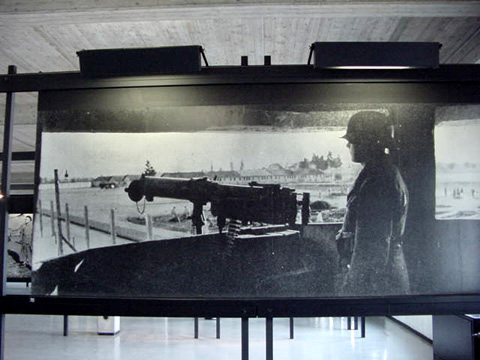 The Museum is the first stop for all the tour groups that visit the Memorial Site on the grounds of the former Dachau concentration camp. It was opened on May 9, 1965 to replace the former museum in the crematorium building which was closed in 1953. The exhibits were planned and arranged by the International Committee of Dachau, an organization of political prisoners which was already in charge of the concentration camp when the American Army arrived in April 1945. The first museum at Dachau was set up in the gas chamber building (Baracke X) by the American Army immediately after the camp was liberated. It was intended primarily to educate American soldiers about Nazi atrocities. The current museum is designed for serious researchers, as well as tourists. The museum archive contains over 14,500 documents and photographs with a library of over 5,000 books. For visitors who know nothing about Dachau or the Holocaust, the museum offers a good introduction, not only to the horrors of the concentration camp system, but also to the Nazi ideology in general and the ever increasing anti-Semitism and persecution of the Jews in Germany which ultimately led to the Final Solution, the Nazi term for the genocide of the Jews. Many documents and Anti-Semitic posters written in the German language are on display so visitors are encouraged to buy the museum book which translates everything. The book can be purchased at the door before you enter the exhibits. Admission to the Museum is free. It is open from 9 to 5 every day of the week except Monday. The first photograph below shows the general layout of the south end of the Dachau Memorial Site where the Museum is located. The exhibits are in the center section of the U-shaped service building, called the Wirtschaftsgebäude, which you see in the center of the photograph. On the left is the east wing of the service building, right by the tourist entrance to the Memorial Site . On the extreme right, you can see the end of one of the two reconstructed barracks, which were built in 1965. The small building in the background on the right is the duty building, which was called the Jourhaus. The entrance for the prisoners was through an iron gate across an opening in the center of this building. By 2003, this will be the new entrance for visitors. The wide expanse of gravel that you see in the photograph is the Appellplatz where prisoners had to line up every morning and evening for roll call. 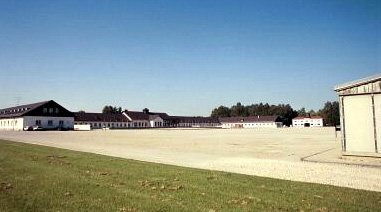 Visitors who already know something about the persecution of the Jews and the Dachau concentration camp might want to save the Museum until last in order to beat the crowds to the new exhibits in the bunker which is behind the service building, or to see the Memorial Site's biggest attraction, the gas chambers, which are located just outside the northwest corner of the prison compound. There is no timed entry to the Museum, and visitors may come and go as they please. The Museum is currently being revamped; new exhibits will be in place by 2003. Possibly these exhibits will show how the camp was used after the inmates were freed by the American liberators. The Memorial Sites at two other major Nazi concentration camps, Buchenwald and Sachsenhausen, have recently added new museums which show how those camps were used after the former inmates were gone. Both Buchenwald and Sachsenhausen were in the former East Germany. After the war, the Communists set up prisons for Nazis in these camps, just as the American Army turned the Dachau concentration camp into a prison camp for suspected Nazi war criminals. These new museums, which were opened after the fall of Communism in 1989, show how the defeated Nazis were mistreated by the Soviet Communists and reveal that the death rate in these prisons was actually higher than in the concentration camps. When I visited the Dachau Museum in May 1997 and again in May 2001, there was nothing in the displays about how the American Army summarily executed German soldiers and allowed the prisoners to beat German guards to death when they liberated the camp. There was nothing about the prison camp for Nazis that the American Army set up in the former concentration camp, nor about the Dachau trials which led to Congressional investigations about allegations of torture used by American military personnel. There was also nothing in the Museum about the German refugees who lived in the barracks of the former concentration camp for almost 10 years. The former camp where the Dachau Memorial Site now stands was actually inhabited by German citizens for a longer period of time than the 12 years that it was a prison for people who were persecuted by the Nazis, but there is no hint of this at the Museum. In May 1997, there was a large section of old photographs in the Dachau Museum which showed scenes from the Nazi death camps in Poland and elsewhere. This section was unavailable when I visited in May 2001. 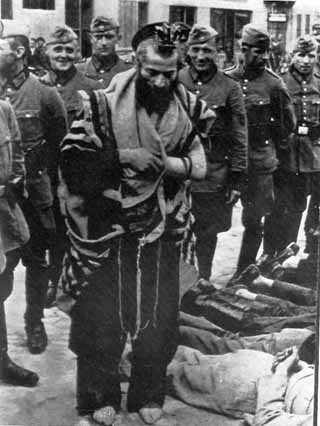 The first section of the Museum exhibit is devoted to the events that led to the political and economic environment which allowed the Nazis to gradually gain popularity. The first thing you learn in this section is that Hitler had virtually no original ideas. The beginning of racial bigotry and Anti-Semitism in modern Germany started as far back as 1853. You also learn that one big complaint
that the Nazis had was the way World War I ended with what was
called "Der Dolchstoss." The photograph below shows
a copy of a popular poster which hangs in the Museum. It depicts
a German soldier who has been "stabbed in the back."
This is a reference to Hitler's claim that Germany did not lose
World War I in the field. The Armistice that ended the war was
signed by the Social Democrats who toppled Germany's imperial
government on November 9, 1918 in a "bloodless revolution."
The Nazis referred to the Social Democrats who signed the Armistice
as the "November criminals." The first prisoners at
the Dachau concentration camp were Communists and Social Democrats,
including some Jews who were active in these two political parties. 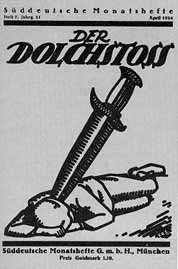 Another poster with the headline "Zur Abwehr" reveals that the Nazis lost no time in persecuting the Jews after Hitler was sworn in as Chancellor of Germany on January 30, 1933. The text of this viciously Anti-Semitic poster calls for a boycott of Jewish stores on April 1, 1933. The prisoner shown in the foreground of the photograph below is not necessarily a Dachau inmate, since the Museum mixes pictures taken at other camps with photographs of Dachau prisoners. Many of the photographs in the Museum were taken by a professional photographer on June 28, 1938 when the newly rebuilt Dachau model camp was nearly finished. In the background of the photograph below, you can see portraits of four Dachau political prisoners and a shot of workers straining to pull a wagon used in the construction of the new camp. All of the professional photographs taken on the same day in 1938 look as though they were posed and the prisoners look well-fed and healthy. Dachau was a "model camp" where many visitors were brought to see how well the concentration camp system functioned. 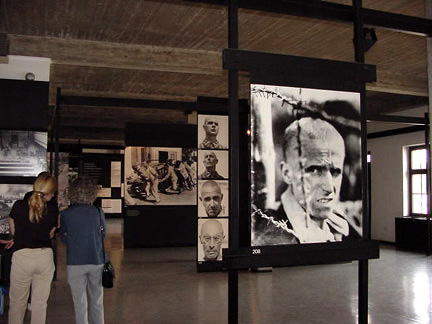 More exhibits in the Dachau MuseumBack to Table of ContentsBack to Dachau IndexHome |